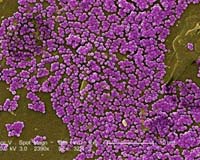 |
Raliegh NC (SPX) May 26, 2009 A new machine developed at North Carolina State University makes an animal heart pump much like a live heart after it has been removed from the animal's body, allowing researchers to expedite the development of new tools and techniques for heart surgery. The machine saves researchers time and money by allowing them to test and refine their technologies in a realistic surgical environment, without the cost and time associated with animal or clinical trials. Currently, most medical device prototypes designed for use in heart surgery are tested on live pigs, which have heart valves that are anatomically similar to human heart valves. However, these tests are both expensive and time-consuming, and involve a lengthy permission process to ensure that the use of live animals is necessary. So, researchers at NC State have developed a "dynamic heart system" - a machine that pumps fluid through a pig heart so that it functions in a very realistic way. "Researchers can obtain pig hearts from a pork processing facility and use the system to test their prototypes or practice new surgical procedures," says Andrew Richards, a Ph. D. student in mechanical engineering at NC State who designed the heart machine. The computer-controlled machine, which operates using pressurized saline solution, also allows researchers to film the interior workings of the pumping heart - enabling them to ascertain exactly which surgical technologies and techniques perform best for repairing heart valves. By using the machine, researchers can determine if concepts for new surgical tools are viable before evaluating them on live animals. They can also identify and address any functional problems with new technological tools. "There will still be a need for testing in live animal models," says Dr. Greg Buckner, who directed the project, "but this system creates an intermediate stage of testing that did not exist before. It allows researchers to do 'proof of concept' evaluations, and refine the designs, before operating on live animals." Buckner is an associate professor of mechanical and aerospace engineering at NC State. Using the system could also save researchers a great deal of money. Once the machine is purchased and set up, the cost of running experiments is orders of magnitude less expensive than using live animals. "It costs approximately $25 to run an experiment on the machine," says Richards, "whereas a similar experiment using a live animal costs approximately $2,500." The National Heart, Lung, and Blood Institute of the National Institutes of Health funded the development of the heart machine system. The Annals of Biomedical Engineering published the research, "A Dynamic Heart System to Facilitate the Development of Mitral Valve Repair Techniques," in late April. Richards is the lead author. Co-authors are Buckner, and surgeons Richard Cook of the University of British Columbia and Gil Bolotin of the Rambam Medical Center in Israel. Share This Article With Planet Earth
Related Links National Heart, Lung, and Blood Institute North Carolina State University Hospital and Medical News at InternDaily.com
 How Superbugs Control Their Lethal Weapons
How Superbugs Control Their Lethal WeaponsLondon, Canada (SPX) May 26, 2009 It appears that some superbugs have evolved to develop the ability to manipulate the immune system to everyone's advantage. A team of researchers at The University of Western Ontario, led by Joaquin (Quim) Madrenas of the Robarts Research Institute, has discovered some processes that reduce the lethal effects of toxins from superbugs, allowing humans and microbes to co-evolve. This ... read more |
|
| The content herein, unless otherwise known to be public domain, are Copyright 1995-2009 - SpaceDaily. AFP and UPI Wire Stories are copyright Agence France-Presse and United Press International. ESA Portal Reports are copyright European Space Agency. All NASA sourced material is public domain. Additional copyrights may apply in whole or part to other bona fide parties. Advertising does not imply endorsement,agreement or approval of any opinions, statements or information provided by SpaceDaily on any Web page published or hosted by SpaceDaily. Privacy Statement |